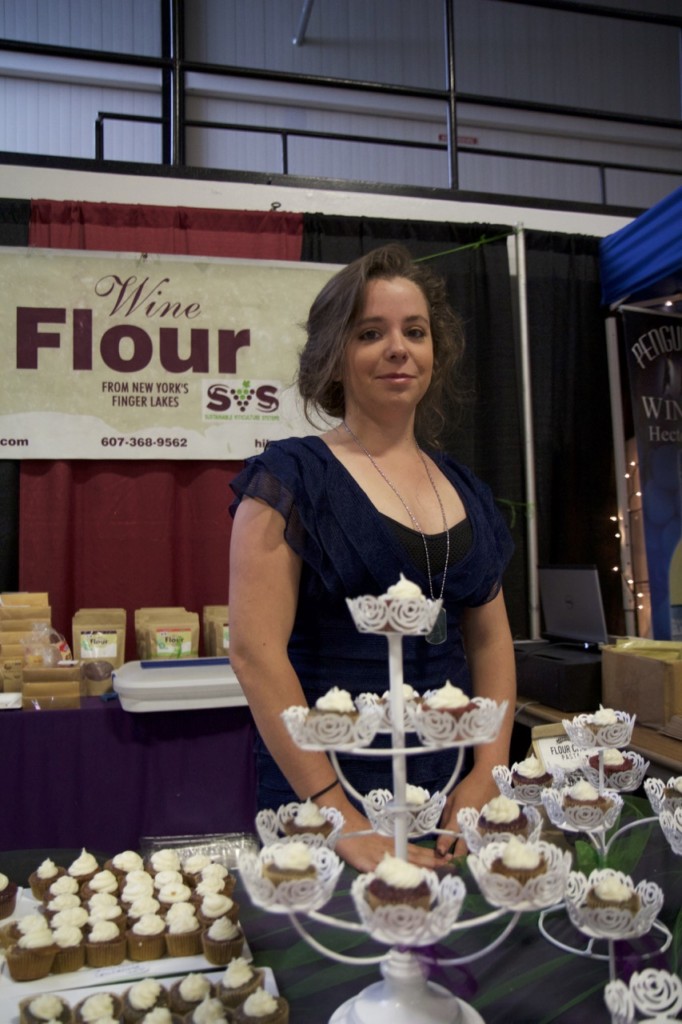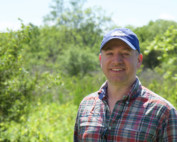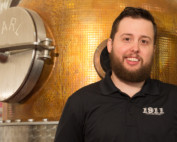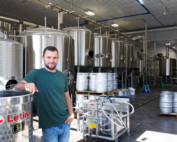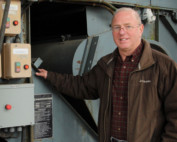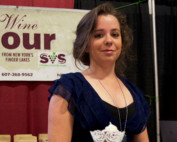W inemaking is an age-old practice, and for as long as people have been producing wine, they’ve produced pomace that has been tossed into the waste pile. Roughly 11,000 tons of grape pomace — seeds and skins — are discarded yearly in New York’s Finger Lakes region after wine is made. Hilary Niver-Johnson ’11, founder and owner of Sustainable Viticulture Systems, transforms these leftovers into something useful: wine flour.
Operating out of a 320-square-foot facility in the town of Hector overlooking Seneca Lake, Niver-Johnson hand-sorts, separates, sun-dries and stone-mills the pomace into colorful and flavorful flours.
“I hand-sift everything, so it’s very labor-intensive, but it also guarantees quality because I see every grain that goes into every bag,” she said.
Made purely from grape seeds and skins, the flours are used as an additive to traditional flour in recipes, infusing dishes with a complexity of rich flavors and colors. The flours reflect the different flavors of the various grapes and, in the case of red varietals, also lend a purple color to the food.
“Purple pancakes, purple pie crusts, purple pizza crusts: It’s a huge way to sell it to kids,” she said.
The flours also add nutritional benefits to foods thanks to the antioxidants, protein, fiber and minerals naturally found in grapes, she said.
Wine flour is a value-added product from the wine production. Most wineries have to find a way to dispose of the pomace, which can be time-consuming and costly. Niver-Johnson gets her supply from three area wineries after the grapes are pressed.
“I haul it off for them and they’re happy it’s taken care of,” she said.
At ESF, Niver-Johnson majored in environmental science with a minor in renewable energy. One of her early research projects, under the direction of Dr. Timothy Volk, involved measuring energy flows in vineyards and wineries to determine energy intensity per bottle. The project drew the attention of the University of Nebraska-Lincoln and Nebraska Renewable Energy Systems, which hired her after graduation to do case studies for wineries in South Dakota, Iowa and Nebraska, where there is a burgeoning wine industry.
It was there that she learned about grape seed oil, but she soon discovered that the oil makes up only a small percentage of the pomace – and a large amount was still being wasted. As she wondered how to use this leftover material, she realized that skin flour was a more economically feasible and useful product.
She returned to New York in 2013 and started developing her own wine flours. SVS began processing in the fall of 2014, with the first products — riesling and cabernet sauvignon flours — launched in June 2015. These were followed by five more varieties by the fall.
Niver-Johnson is the only producer of wine flours on the East Coast. “I’ve got pretty much all the market shares over here,” she said.
Counting her research at ESF, she is in her sixth year of value-added grape research. In the last two years, she’s developed a number of products including a wine flour cupcake line, wine flour chocolate truffles and grape skin bran. She is developing crackers with Cornell University but has launched her own cracker line on her website.
“I love trying new things with the wine flours,” she said. “You can really make it a vibrant flavor, especially if you use grape seed oil in your recipes along with wine. I try to bake and cook with wine whenever I can. It really brings out the flavor of the grape and the wine in our area, which is really cool.”
If flour production weren’t enough to have on her plate, Niver-Johnson hopes to add even more value to the humble grape — renewable energy technologies. When a grape seed is pressed for oil, the leftover pellet, a press cake, can be burned in a pellet stove and has Btu similar to woody biomass pellets. “You don’t have to alter them in any way,” she said. “Just put them in a stove. They’ll make your winery, business or home smell like grapes.”
She has applied to do a technology incubator program to conduct research on the process, obtain supplies and possibly build a prototype.
“I absolutely love doing research, and ESF only enhanced my love for it. You’re constantly doing research projects in every class, which is great. … ESF played a major role in how I developed this business and fostered my passion for sustainability, recycling and waste management. It was a great experience then and continues to be five years after graduation,” she said.



